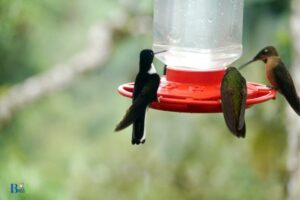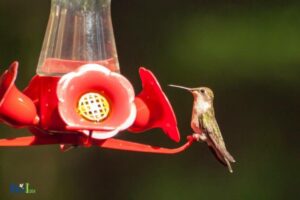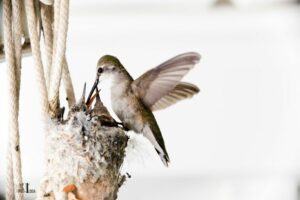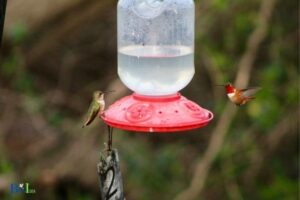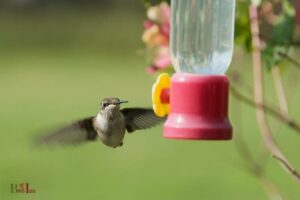How to Keep Cats Away from Hummingbird Feeders: Motion!
To keep cats away from hummingbird feeders, you should place the feeders in high, inaccessible locations, use motion-activated deterrents, create barriers, and provide alternative attractants for the cats.
Cats are natural predators, and hummingbirds can be an irresistible target for them. Keeping cats away from hummingbird feeders is essential for the safety of the birds and ensuring they can feed peacefully.
By taking a few preventive measures, you can create a safe environment for hummingbirds and avoid any unwanted visits from curious cats.
Motion-activated deterrents like sprinklers or air blasters can startle cats and keep them away from the area around the feeder. Creating barriers such as fencing, netting, or planting prickly bushes around the feeder can make it difficult for cats to access the area.
Lastly, providing alternative sources of entertainment for the cats in the form of toys or catnip will keep them engaged elsewhere, reducing their interest in the hummingbird feeder.
7 Methods: How to Keep Cats Away from Hummingbird Feeders
| Method | Description | Pros | Cons |
| Hang the feeder high | Hang the hummingbird feeder at least 5 feet off the ground to prevent cats from jumping and reaching it | Easy to do; uses existing feeder location | May not deter all athletic cats |
| Use a baffle | Attach a baffle (cone-shaped barrier) to the pole holding the feeder to prevent cats from climbing it | Effective; keeps other pests away as well | Additional purchase required; may not work on trees or other unconventional supports |
| Hang the feeder near windows | Hang the feeder close to windows where birds are less likely to be injured if chased by a cat | Accessible for birds; easy to observe | May attract other unwanted animals close to your home |
| Plant deterrents | Plant cat-repelling shrubs or flowers like lavender, rue, or geranium around the area where the hummingbird feeder is located | Natural solution; adds beauty to your garden | Requires maintenance; may not be 100% effective |
| Use a feeder with a built-in moat | Purchase a hummingbird feeder that has a moat or water barrier to deter ants and cats | Effective against both insects and cats; no extra installation needed | Additional purchase required; may not deter all persistent cats |
| Keep your pet cat indoors | Restrict your own cat’s access to the yard or garden to prevent them from disturbing hummingbirds | Protects feeder without additional installations; safer for the cat | May not apply to non-pet owners; requires monitoring of your cat |
| Install a motion-activated sprinkler | Set up a motion-activated sprinkler system near the feeder to scare away approaching cats | Effective for deterring various pests; conserves water when not triggered | Requires purchase and installation; may inadvertently scare the hummingbirds, too |
Key Takeaway
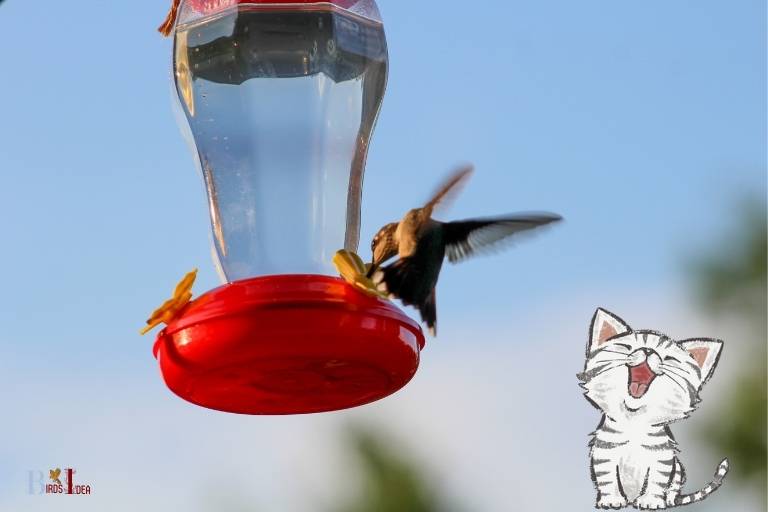
Five Facts About: Keep Cats Away from Hummingbird Feeders
Understanding The Problem
Hummingbirds are not only a delight to see in your garden but they also help in pollination. However, attracting hummingbirds to your garden can also attract cats, which can pose a threat to not only hummingbirds but also other small birds.
Understanding how cats pose a threat to birds and their physical and behavioural characteristics can help you keep them away from your hummingbird feeders.
Explanation Of How Cats Pose A Threat To Hummingbirds And Other Small Birds
Cat’s hunting instincts and their natural predatory behaviour towards birds are the primary threat to hummingbirds and other small birds.
Here are some ways cats pose a threat:
- Cats can catch and kill birds by pouncing on them.
- They can climb trees, where birds and their nests may be located, and can attack them from above.
- Even if they cannot catch the bird, their presence alone could cause enough stress to the bird that it could die from shock.
Overview Of The Physical And Behavioural Characteristics Of Cats That Make Them Effective Hunters
Cats are naturally skilled hunters; they have excellent hearing, night vision, and predatory instincts.
Here are some physical and behavioural characteristics that make them effective hunters:
- Sharp teeth and claws that can cause severe injuries to birds.
- Quick reflexes and excellent speed and agility, allowing them to pounce upon birds without warning.
- Hunters by nature, cats are always on the lookout for prey, including birds.
Discussion Of Why Bird Enthusiasts May Want To Keep Their Cats Away From Hummingbird Feeders
Keeping your cats away from hummingbird feeders can help preserve the lives of not only hummingbirds but also other small birds.
Here are some reasons why bird enthusiasts may want to keep cats away:
- Helping hummingbirds and other small birds survive by stopping them from being hunted by cats.
- Demonstrating our love for animals by keeping both birds and cats safe in our gardens.
- Avoiding fines: In some areas keeping a cat away from your hummingbird feeder is mandatory.
Natural Ways To Keep Cats Away
Highlighting Natural Methods That Can Help To Keep Cats Away From Feeders, Including Plants, Scents, And Repellents
There are several natural methods available to deter cats from trespassing on your hummingbird feeder. These range from using plants and scents to applying repellents.
Here are the key points to keep in mind:
- Plants: Some plants such as lavender, rue, pennyroyal, and coleus can be used to keep cats away from hummingbird feeders. The strong scents of these plants are unpleasant to cats, and they tend to avoid areas where they are planted.
- Scents: If you do not want to plant any new flowers or herbs, you can also use essential oils or citrus peels to ward off cats. You can dilute essential oils like peppermint, lavender, or lemon in water and spray them around the feeder. Alternatively, scattering citrus peels around the feeder can also work as a natural cat repellent.
- Repellents: Several natural cat repellents are available in the market, including motion-activated water sprayers, ultrasonic sound emitters, and cat repellent sprays. Motion-activated water sprayers utilize infrared sensors to detect cats’ presence and then spray a jet of water to scare them away. Ultrasonic sound emitters produce sounds that are unpleasant to cats but are inaudible to humans. Lastly, cat repellent sprays typically contain scent deterrents that prevent cats from approaching the feeder.
Before using any of these natural methods, you need to keep the following tips in mind:
- Rotate the natural cat repellents frequently to prevent cats from getting used to them.
- Make sure to use a cat deterrent that is safe for hummingbirds and other wildlife.
- Apply repellents both to the area around the feeder and at the entrance to your yard to prevent cats from entering your property.
- Regularly clean the area around the feeder and replace the nectar to eliminate any odors that may attract cats.
Providing A Detailed Explanation Of How Each Method Works, And Tips For Using Them Effectively
Here’s a more detailed explanation of how these natural methods work and how you can employ them effectively:
- Plants: The plants listed above are known for their strong scents that cats dislike. The scent acts as a deterrent, causing cats to avoid the area. When planting these herbs, make sure you include them in areas where a cat’s entry can be prevented. You can also plant them in pots to move them around the yard easily.
- Scents: Essential oils like lavender, peppermint, and lemon can be used to create a strong scent that cats dislike. You can also use citrus peels to ward off cats. Both of these options are easy to use. Dilute the essential oils in water and spray, or scatter citrus peels around the path that cats usually take to reach the feeder.
- Repellents: Motion-activated water sprayers detect any motion around the feeder and spray a jet of water to scare cats away. Ultrasonic sound emitters create sounds that cats find unpleasant, which deters them from approaching the hummingbird feeder. Cat repellent sprays work by creating a scent that cats dislike. These sprays are easy to use; make sure to apply them regularly to prevent cats from returning.
Pros And Cons Of Using Natural Methods To Deter Cats
While natural methods for deterring cats from hummingbird feeders can be effective, they have their pros and cons.
Some of the advantages are:
- They are safe, natural, and humane.
- They do not harm cats or other animals.
- They are affordable and readily available.
However, some of the disadvantages include:
- They may not be as effective as commercial cat repellents or deterrents.
- They require still more effort than other types of deterrence.
- Cats can become desensitized to the scent of essential oils or sprays.
Despite these factors, it is worth using natural methods to deter cats from hummingbird feeders first. They are a safe, cost-effective, and humane solution that can help you to protect your hummingbirds from feline predators.
Technological Solutions
Overview Of Technological Tools That Can Help To Keep Cats Away From Hummingbird Feeders, Such As Motion Detectors And Noise Machines:
If you’re a bird lover, you must be familiar with the unending problem of keeping cats away from hummingbird feeders. But, there’s good news; new technological tools can help you solve this problem.
Below are some of the tools you can employ to keep your hummingbirds safe from cats:
Motion Detectors:
Motion detectors are devices that can detect movements and send signals to other devices, such as cameras or alarms.
They have become increasingly popular as they can help detect potential threats from a distance and activate other devices to keep animals away from restricted areas.
- Motion detectors can help keep cats away from your hummingbird feeders as they can detect their movement and activate other devices to scare them.
- These devices can be installed easily and are effective in their task of detecting movements.
Noise Machines:
Noise machines can emit sounds that cats find unpleasant, such as the sounds of dogs barking or alarms ringing.
They have become more popular as people are becoming increasingly aware of the dangers and risks of keeping cats away from certain areas, such as bird feeders.
- Noise machines can help keep cats away from your hummingbird feeders by emitting unpleasant sounds that make them uncomfortable and discourage them from coming close.
- These devices can be installed easily and are effective in their task of scaring away cats.
Detailed Explanation Of How Each Tool Works And Its Effectiveness:
Motion detectors and noise machines are some of the most popular technological tools used to keep cats away from hummingbird feeders.
Here’s a detailed overview of how each tool works and its effectiveness in deterring cats:
Motion Detectors:
- Motion detectors use sensors to detect movements within their range. Once detected, they activate other devices that can scare away animals, such as sprinklers and alarms.
- They can be programmed to distinguish between human and animal movements, which lowers the risk of false alarms.
- In terms of effectiveness, motion detectors are highly reliable and can detect animals from far away. They can, however, be expensive to install.
Noise Machines:
- Noise machines emit sounds that cats find unpleasant, triggering their instinct to stay away from specific areas. The sounds can be anything from barking dogs to alarms.
- They emit varying sound levels and can be customized to different decibel levels to prevent cats from becoming familiar with certain sounds and adapting to them.
- Noise machines are affordable and straightforward to use, making them an excellent entry-level solution to the problem of keeping cats away from hummingbird feeders. However, they have a limited range and are often not as effective as motion detectors.
Pros And Cons Of Using Technological Solutions To Deter Cats:
While technological tools can effectively keep cats away from hummingbird feeders, there are still some pros and cons you should consider before making your choice.
Here are some of the advantages and disadvantages of using technological solutions:
Pros:
- Technological solutions are effective at keeping cats away from hummingbird feeders.
- They provide a long-term solution to the problem and ensure that your hummingbirds are safe.
- They give you peace of mind, knowing that your birds are safe even when you’re not around.
- They can be programmed to be animal-friendly, ensuring that only intruders are scared off.
Cons:
- Technological solutions can be expensive, especially when installing motion detectors.
- They require maintenance and monitoring to ensure that they function correctly.
- These devices can be triggered by other animals or objects, leading to false alarms.
- They can be unsightly and may clash with your garden’s aesthetics.
There is no one-size-fits-all answer to keeping cats away from hummingbird feeders.
But, technological tools have become increasingly popular and can effectively solve the problem. The decision lies upon you to weigh the pros and cons and choose the solution that best fits your needs.
Raising Awareness
Discussion Of The Importance Of Raising Awareness About The Threat Of Cats To Hummingbirds
Hummingbirds are delicate creatures, and they face a constant threat from predators, with cats being one of the main offenders.
To prevent cats from preying on our hummingbirds and damaging the ecosystem, it is crucial to raise awareness about this issue.
Here are some key points to consider:
- Despite being domesticated, cats still retain their predatory instincts, which can be deadly for hummingbirds.
- Cats account for a significant proportion of bird deaths in the us, so it’s a concern that should not be taken lightly.
- Raising awareness about the threat of cats to hummingbirds can help people understand the importance of protecting these vulnerable creatures and take steps to prevent harm.
Providing Tips For Raising Awareness Among The Community
To tackle the issue of cat predation, it is important to raise awareness within the community.
Here are some tips on how you can do that:
- Distribute educational brochures and flyers in public areas such as parks, community centres, and schools.
- Host events such as talks or workshops to educate the community on the consequences of cat predation.
- Share content about the issue on social media platforms to reach a wide audience.
- Encourage cat owners to keep their pets indoors or supervised when outside, especially during hummingbird migration season.
- Provide community members with resources such as tips on how to prevent cat-human conflicts and safe bird feeding practices.
Highlighting Organizations And Campaigns Focused On Protecting Birds From Cats
Several organizations have created campaigns to raise awareness about the dangers that cats pose to birds.
If you’re interested in getting involved, here are some examples:
- American bird conservancy’s ‘cats indoors!’ Campaign promotes responsible cat ownership and keeping cats indoors to protect birds and other wildlife.
- The humane society of the united states has a wildlife-friendly communities program, which helps communities prevent conflicts between cats and birds, among other initiatives.
- Project purr advocates for outdoor cats to be transitioned to indoor pets to prevent them from preying on birds and other wildlife.
Getting involved with these organizations can be a great way to support the protection of hummingbirds and other birds from cat predation, whether through volunteering, donating, or spreading awareness.
FAQ Of How To Keep Cats Away From Hummingbird Feeders
Why Do Cats Eat Hummingbirds, And How Can I Keep Them Away?
How Can I Prevent Cats From Climbing My Feeder Poles?
Can I Spray Repellents Directly On My Hummingbird Feeder?
What Alternative Food Sources Can I Provide For Cats In My Yard?
Conclusion
You love hummingbirds and want to enjoy watching them feed from your backyard hummingbird feeder. However, cats are frequent visitors in your neighborhood and can pose a threat to hummingbirds.
Thankfully, there are several effective ways to keep cats away from your hummingbird feeders.
You can use physical barriers, such as cages or mesh, to keep cats out. Alternatively, use a motion-activated sprinkler to startle them away from the feeder area. Avoid using harmful substances like mothballs or chemical sprays, which can endanger the hummingbirds.
Make sure to provide enough food and water for your local cats to prevent them from hunting hummingbirds for food. By following these tips, you can help ensure that your backyard is a safe haven for hummingbirds and not a hunting ground for cats.
So sit back, relax, and enjoy watching these beautiful and fascinating birds.

